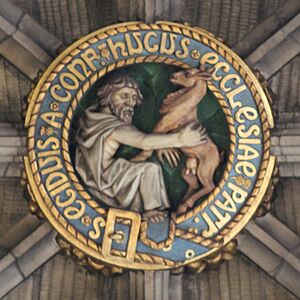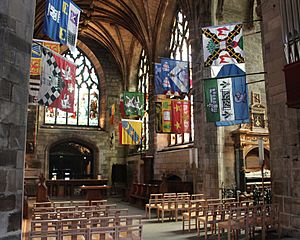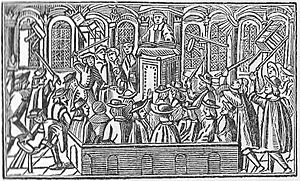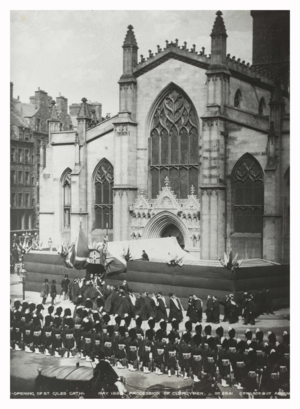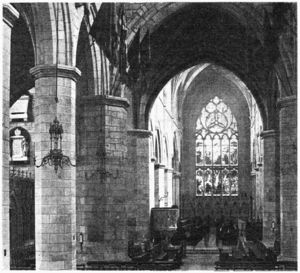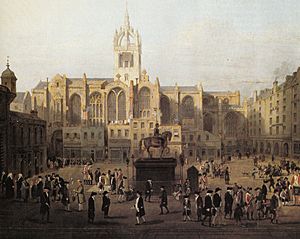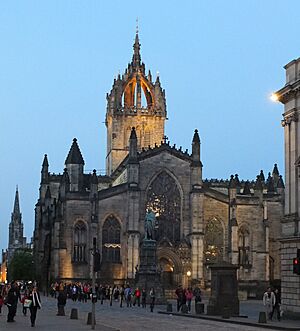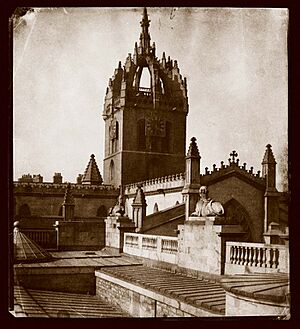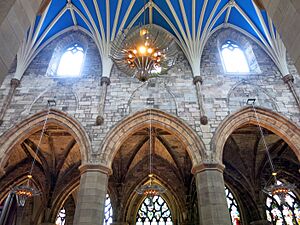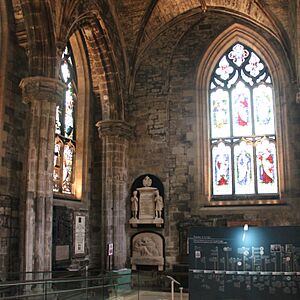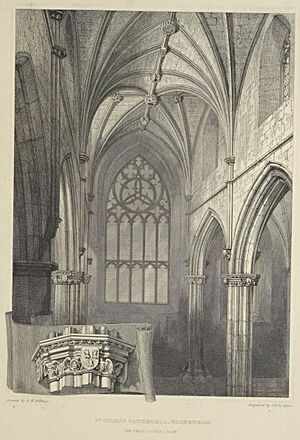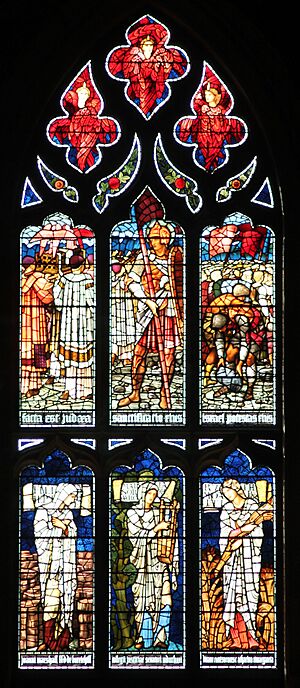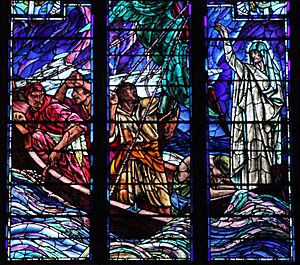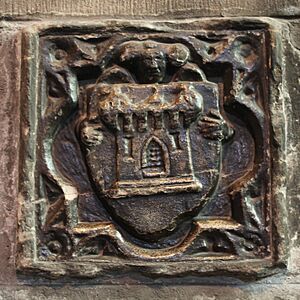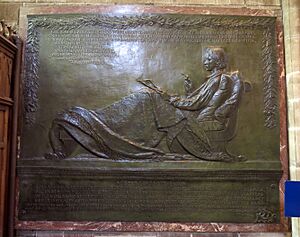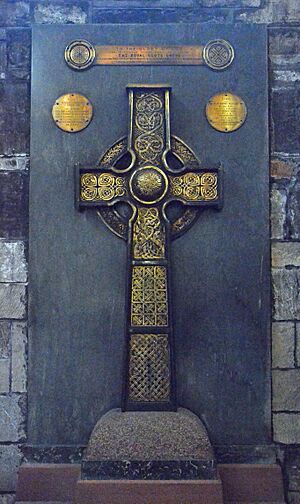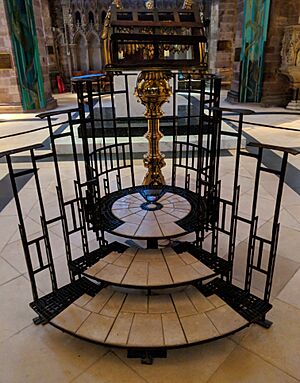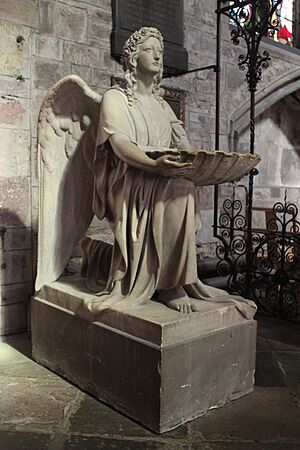St Giles' Cathedral facts for kids
Quick facts for kids St Giles' Cathedral |
|
|---|---|
| High Kirk of Edinburgh | |
|
Cathair-eaglais Naomh Giles
|
|
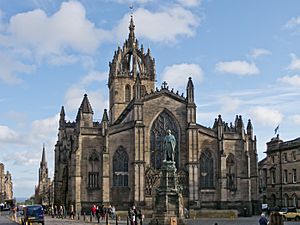
West façade of the church building
|
|
| 55°56′58″N 03°11′27″W / 55.94944°N 3.19083°W | |
| Location | Royal Mile, Edinburgh |
| Country | Scotland |
| Denomination | Church of Scotland |
| Previous denomination | Roman Catholic |
| History | |
| Status | Parish church |
| Founded | 12th century |
| Dedication | Saint Giles |
| Consecrated | 6 October 1243 |
| Past bishop(s) | Bishop of Edinburgh |
| Architecture | |
| Functional status | Active |
| Heritage designation | Category A listed building |
| Designated | 14 December 1970 |
| Style | Gothic |
| Specifications | |
| Length | 196 feet (60 metres) |
| Width | 125 feet (38 metres) |
| Height | 52 feet (16 metres) |
| Spire height | 145 feet (44 metres) |
| Bells | 3 |
| Administration | |
| Presbytery | Edinburgh |
St Giles' Cathedral (Scottish Gaelic: Cathair-eaglais Naomh Giles), also known as the High Kirk of Edinburgh, is a famous church in the Old Town of Edinburgh, Scotland. It's a parish church of the Church of Scotland. The main building you see today started being built in the 1300s. It was added to and changed a lot over the centuries. One important addition was the Thistle Chapel. St Giles' has been part of many big moments in Scottish history. Important people like John Knox, a key figure in the Scottish Reformation, served as a minister here.
The church was probably started in the 1100s and named after Saint Giles. In 1467, it became a "collegiate church," which meant it had a group of clergy working together. In 1559, during the Scottish Reformation, it became a Protestant church. After this, St Giles' was even divided inside to hold different church groups. It was also used for other things, like a prison or a meeting place for the Scottish Parliament.
In 1633, King Charles I made St Giles' a cathedral for a new church area. His attempt to change how the church worshipped led to a riot in 1637. This event helped start the Covenanters movement and the Wars of the Three Kingdoms. Because of its role in these big events, St Giles' is sometimes called "the Mother Church of World Presbyterianism".
St Giles' is one of Scotland's most important medieval churches. The first church here was a small Romanesque building. In the 1300s, a new Gothic building replaced it. This building was made bigger between the late 1300s and early 1500s. The church was later changed by William Burn (1829-1833) and restored by William Hay (1872-1883). William Chambers, a publisher, helped with the restoration. He hoped to make St Giles' a "Westminster Abbey for Scotland." This meant adding memorials to famous Scots. The beautiful Thistle Chapel was added between 1909 and 1911.
Since medieval times, St Giles' has hosted important national events. Services for the Order of the Thistle are held here. The church is still active today and is also a popular place for visitors. In 2018, over a million people visited St Giles'.
Contents
What's in a Name?
Saint Giles is the special saint for people with leprosy. He was very popular in medieval Scotland. The church was first owned by monks who helped lepers. The name might be linked to Queen Matilda, who founded another St Giles' church.
Before the Scottish Reformation, St Giles' was the only parish church in Edinburgh. Some writers just called it the "church of Edinburgh." From 1467, when it became a "collegiate church," its full name was "the Collegiate Church of St Giles of Edinburgh."
St Giles' was a cathedral twice: from 1633 to 1638 and again from 1661 to 1689. This was when the Church of Scotland had bishops. Since 1689, the Church of Scotland has been Presbyterian. This means it doesn't have bishops, so it doesn't have cathedrals. St Giles' is like other former cathedrals in Scotland, such as Glasgow Cathedral. They keep the "cathedral" name even though they no longer have that status.
The name "High Kirk" was used in the 1600s for the whole building. It became popular again in the late 1700s. Since 1883, the main church group has used the entire building.
Where is St Giles' Cathedral?
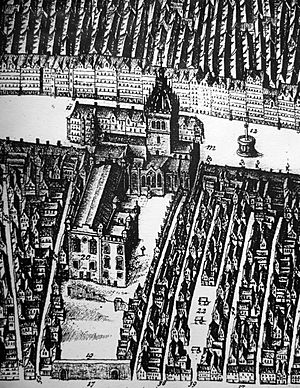
Experts say St Giles' is "the central focus of the Old Town." The church sits on a flat part of the ridge leading from Edinburgh Castle. It's on the south side of the High Street, which is the main street of the Old Town. This street is part of the famous Royal Mile.
When it was first built in the 1100s, St Giles' was near the edge of Edinburgh. By the mid-1400s, the town had grown. St Giles' was then close to the center. In medieval and early modern times, it was also at the heart of Edinburgh's city life. The Tolbooth, the city's main office, was right next to it. The Mercat Cross, Edinburgh, where markets were held, was also very close.
For a long time, the Luckenbooths and Tolbooth buildings made the High Street very narrow around St Giles'. There was even a small lane called Stinkand Style. Market stalls were set up between the church's buttresses in this lane.
St Giles' forms the north side of Parliament Square. The Law Courts are on the south side. The area south of the church used to be a churchyard, where people were buried. For over 450 years, it was the main burial ground for Edinburgh. This area was closed for burials in 1561. Later, Parliament House was built there, creating the square.
A Look Back in Time
Early Years
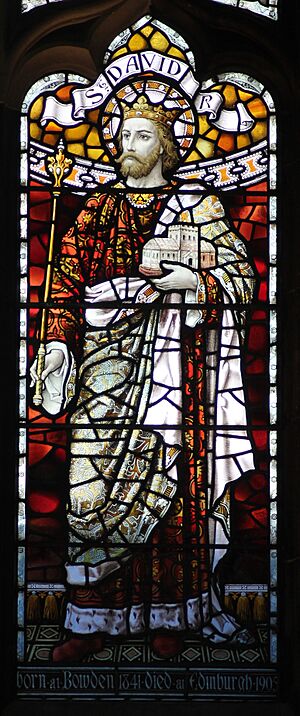
St Giles' was probably founded in 1124 by King David I. It was likely separated from an older church area. David I made Edinburgh a burgh (a type of town). The church and its lands were first owned by monks who helped lepers. Parts of the old Romanesque church look similar to a church built between 1140 and 1166. St Giles' was officially blessed by a bishop in 1243.
In 1322, during a war with England, English troops might have attacked St Giles'. In 1385, the church was burned by King Richard II's army. Burn marks were still visible on the pillars in the 1800s.
At some point in the 1300s, the old Romanesque church was replaced by the current Gothic building. More chapels were added to the church in 1387.
In the 1370s, St Giles' became part of the Scottish crown again. In 1393, King Robert III gave St Giles' to an abbey. But it seems to have returned to the crown soon after.
Becoming a Collegiate Church
In 1467, Pope Paul II officially made St Giles' a "collegiate church." This meant it had a special group of clergy, including a provost and sixteen canons.
Around this time, William Preston of Gorton brought a special bone of Saint Giles from France. To honor him, the Preston Aisle was added to the church. Preston's family had the right to carry this relic in the Saint Giles' Day parade. Around 1460, the church's main area was extended. Queen Mary of Guelders may have helped pay for this to remember her husband, King James II.
After it became a collegiate church, many more altars and gifts were added. By the time of the Reformation, there might have been as many as fifty altars. In 1470, the Pope gave St Giles' even more special status.
In 1513, after the sad Battle of Flodden, St Giles' was a central place for Scotland. Women were told to gather in the church to pray for King James IV and his army. Special services were held for the King and those who died in the battle.
In 1544, during a war with England, soldiers were stationed in the church tower.
Early signs of Protestant ideas appeared at St Giles' in 1535. In 1556, images were stolen from the church. In 1557, the statue of Saint Giles was stolen and destroyed. It was replaced by a borrowed statue, but Protestants damaged that one too during a parade.
The Reformation Begins
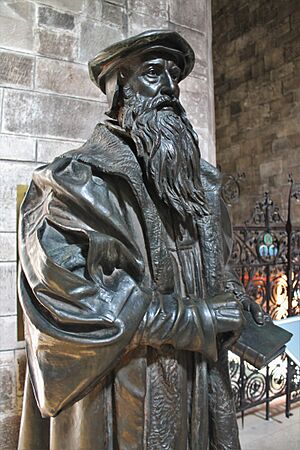
In 1559, as the Scottish Reformation grew, the city hired soldiers to protect St Giles'. On June 29, 1559, the Protestant army entered Edinburgh. That afternoon, John Knox, a key leader of the Reformation, preached in St Giles' for the first time. The next week, Knox became the minister. Soon after, the church began removing its Roman Catholic decorations.
The Queen, Mary of Guise, offered another church for Catholics. But St Giles' stayed Protestant. Knox left for a short time, but his helper kept preaching. French soldiers even tried to stop the sermons.
Later, Catholics took Edinburgh back. St Giles' was made a Catholic church again in November 1559. But after England helped the Protestants, they took Edinburgh back. St Giles' became a Protestant church again on April 1, 1560. Knox returned. In August 1560, the Scottish Parliament said the Pope had no power in Scotland.
Workers spent nine days clearing stone altars and monuments from the church. Valuable items were sold. The church walls were painted white and green. The Ten Commandments and Lord's Prayer were painted on the walls. Seats were put in for children and city leaders. A pulpit was also added. In 1561, the churchyard was closed for burials.
Church and Crown: 1567–1633
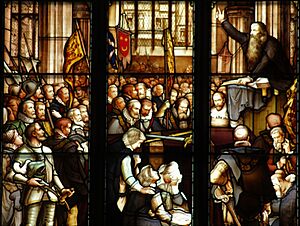
In 1567, Mary, Queen of Scots was removed from power. St Giles' became very important during the civil war that followed. After he was killed in 1570, Regent Moray, a leader against Mary, was buried in the church. John Knox preached at his funeral. Soldiers and cannons were even placed in the church tower in 1572. Knox, who was ill, preached his last sermon in St Giles' in November 1572. He died later that month and was buried nearby.
After the Reformation, parts of St Giles' were used for non-religious things. From 1562, the western part of the church was used as an extension of the Tolbooth. It held criminal courts and the Scottish Parliament. People who broke church rules were imprisoned in a room above the north door. The tower was also used as a prison. Even an early form of guillotine was stored in the church.
Around 1581, the inside of the church was divided into two main meeting areas. These groups shared a church council. In 1598, another part was turned into a third church area.
King James VI often had problems with the ministers of St Giles'. They would criticize him in their sermons. James wanted to bring bishops back into the Church of Scotland. This caused more tension. In 1596, there was a riot at St Giles'. The King blamed the ministers, who had to leave the city. To weaken the ministers, James divided Edinburgh into separate church areas in 1598.
Becoming a Cathedral (Again)
King Charles I visited St Giles' in 1633. He wanted services to be more like the Church of England. In September 1633, Charles made St Giles' a cathedral for a new bishop. Work began to remove the inside walls and decorate it like a cathedral.
But this work was not finished when, on July 23, 1637, a new prayer book was used in St Giles'. This book was seen as too much like Catholic worship. It caused a riot! Legend says a market trader named Jenny Geddes threw her stool at the dean (a church leader). This unrest led to the signing of the National Covenant in 1638. This started the Bishops' Wars, which were part of the Wars of the Three Kingdoms. St Giles' became a Presbyterian church again, and the internal walls were put back.

In 1641, King Charles I attended Presbyterian services in St Giles'. He had lost the Bishops' Wars and had to agree to new laws.
After a battle in 1650, soldiers of Oliver Cromwell's army occupied part of St Giles'. Cromwell himself even preached there.
In 1660, when the monarchy was restored, St Giles' became a cathedral again. King Charles II ordered the body of James Graham, 1st Marquess of Montrose, a supporter of his father, to be re-buried in St Giles'. The return of bishops led to more rebellion. Covenanters were imprisoned in the church.
After the Glorious Revolution in 1688, the Scottish Parliament brought back Presbyterianism in 1689. Many ministers and church members left the Church of Scotland. The last Bishop of Edinburgh led many people out of St Giles' to form a new church.
Four Churches in One: 1689–1843
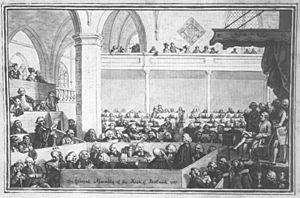
In 1699, a courtroom in St Giles' was turned into another church area. In 1707, when Scotland and England joined parliaments, the bells of St Giles' played a tune. During the Jacobite rising of 1745, Edinburgh citizens met in St Giles' to agree to surrender the city.
In the late 1700s, famous thinkers like Hugh Blair and Alexander Webster preached in St Giles'. Blair's sermons were very popular.
In the early 1800s, buildings around St Giles' were torn down. This showed that the church walls were leaning outwards. In 1817, plans were made to restore the church, but nothing happened due to lack of money.
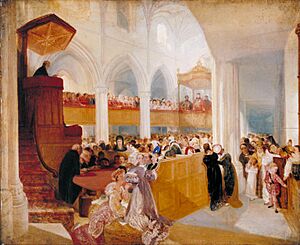
King George IV visited St Giles' in 1822. This visit helped get money for the church's restoration. William Burn led this work from 1829 to 1833. Burn changed the church a lot. He covered the outside with polished stone. He also raised the roof and changed the inside walls. He created a church in the nave, a church in the choir, and a meeting place for the church's General Assembly. He also removed old monuments and the last non-religious spaces.
Some people liked Burn's work, saying it made the building stronger. Others were sad about what was lost. Later, people realized Burn's work saved the church from falling down.
The Victorian Era
In 1843, many ministers and church members left the established church to form the Free Church. This included ministers from St Giles'.
In 1867, William Chambers, a publisher and city leader, wanted to remove the internal walls. He wanted to restore St Giles' to be like "Westminster Abbey for Scotland." He hired William Hay as the architect.
The restoration was part of a movement to make Scottish Presbyterian churches more beautiful. Some people worried it would look too much like a Catholic church. But the plans were approved. The High Kirk was restored between 1872 and 1873. Pews were replaced with stalls and chairs. For the first time since the Reformation, stained glass and an organ were added.
The restoration of other parts of the church began in 1879. Many human remains were found and reburied. William Chambers died just before the church officially reopened in May 1883. His funeral was held in the restored church.
20th and 21st Centuries
In 1911, King George V opened the new Order of the Thistle chapel.
During World War I, 99 members of the church, including an assistant minister, were killed. In 1917, the funeral of Elsie Inglis, a medical pioneer, was held here.
In 1925, ownership of St Giles' was transferred from the city council to the Church of Scotland.
The church was not damaged in World War II. After the war, the royal family attended a service here. A part of the church was made into a memorial chapel for the 39 members of the church killed in the war.
In 1953, Queen Elizabeth II received the Honours of Scotland at a special service in St Giles'. This was after her coronation.
From 1973 to 2013, Gilleasbuig Macmillan was the minister. During his time, the church was restored again. The inside was changed to have a central communion table.
St Giles' is still an active church today. It also hosts concerts and special events. In 2018, it was one of Scotland's most popular visitor sites.
On September 12, 2022, Queen Elizabeth II's coffin was brought to the cathedral for a service. It then lay at rest for 24 hours, allowing people to pay their respects. Her children, including King Charles III, held a special vigil.
On July 5, 2023, the Honours of Scotland were presented to King Charles III in St Giles' Cathedral. This marked his coronation.
Church Design and Architecture
The first St Giles' was likely a small, Romanesque building from the 1100s. It had a rectangular main area and a round end part. An aisle was added to the south before the mid-1200s.
By 1385, this building was probably replaced by the core of the current Gothic church. It had a main area (nave), a central part (crossing), and a choir. The church was made bigger in stages between 1387 and 1518. Many chapels were added, making the layout very complex. This style, with many outer aisles, is common in French medieval churches but unusual in Britain.
Few big changes were made until William Burn's restoration in 1829–1833. He removed some parts, added upper windows, and covered the outside in polished stone. The church was greatly restored again by William Hay between 1872 and 1883. He removed the last internal walls. The Thistle Chapel was added in 1909–11. More recent work in 1979 leveled the floor and changed the inside to have a central communion table.
Outside the Church
The outside of the church, except for the tower, mostly dates from William Burn's restoration (1829–1833) and later. Before this, St Giles' looked very complex because of all its additions.
After nearby buildings were torn down in the early 1800s, it was clear the church walls were leaning. Burn covered the outside with polished gray sandstone. This layer was tied to the old walls. Burn worked with another architect to make sure the new buildings in Parliament Square matched. He changed the church's shape, making the transepts bigger and adding new doors.
Burn created a balanced front (façade) on the west side. The west doorway was added during the Victorian restoration by William Hay. It has statues of Scottish kings, queens, and church leaders. A carving of Saint Giles is above the door.
Burn also removed the two westernmost sections of the outer south nave aisle. This included a south porch and door. He also removed a north porch. These porches were grand, two-story structures.
Before Burn's restoration, some windows still had their original stone patterns. Burn kept the pattern of the great east window. He added new patterns to other windows, based on old Scottish designs.
Tower and Crown Steeple
St Giles' has a tower in the middle, above its crossing. This is common in large Scottish churches. The lower part of the tower was probably finished by 1416. The upper part has groups of three pointed windows.
St Giles' famous crown steeple is one of Edinburgh's most recognizable landmarks. It was built between 1460 and 1467. It's one of only two medieval crown steeples left in Scotland. The design came from England. St Giles' steeple is special because it has eight supports, not just four.
In 1590, 21 weather vanes were added to the steeple. These were removed before 1800, but new ones were put up in 2005. The steeple was repaired in 1648. A weathercock (a metal rooster that shows wind direction) was added in 1667.
The nave is the main part of the church where people sit. It's one of the oldest parts, from the 1300s, but it has been changed a lot.
The ceiling of the nave was added during William Burn's restoration (1829–1833). Burn also made the nave walls taller by about 16 feet, adding windows to let in more light. He also removed a small attic area.
The current arches and pillars were added by William Hay in 1882. Burn had earlier changed the medieval arches and pillars. The original south arches were lower, with windows above them. You can still see the outline of these old windows.
The ceiling of the north nave aisle is vaulted, similar to the Albany Aisle. This suggests they were built around the same time, in the early 1400s.
The Albany Aisle was added to the north side of the nave in the early 1400s. It has a stone vaulted ceiling. The west window was blocked up during the Burn restoration. The north wall has a tomb area. The ceiling supports show the shields of the people who paid for it. This aisle was given to make up for their part in the death of David Stewart, Duke of Rothesay. In 1882, the floor was paved with special tiles. After World War II, it became a memorial chapel.
East of the Albany Aisle, two light-colored stones mark where the old Norman north door was. This door was the only part of the 1100s Romanesque church still in its original place until the late 1700s. A porch stood over this door until Burn's restoration.
Only the easternmost of two chapels north of the nave aisle, the St Eloi Aisle, survived Burn's restoration. Its ceiling was added during William Hay's restoration. An old Romanesque stone from the original church is in its west wall. The floor of the St Eloi Aisle has marble and mosaic panels.
The inner and outer south nave aisles were probably started in the late 1400s. They were likely finished by 1510. These aisles replaced older chapels. The inner aisle still has its original vaulted ceiling. However, the outer aisle's ceiling was added during William Burn's restoration. Burn removed the two westernmost sections of the outer aisle. You can still see a gap where these parts used to be.
In 1513, the Holy Blood Aisle was added. It's named after a special group. Part of this aisle was removed during Burn's restoration and turned into a heating room. It was later restored for church use.
Crossing and Transepts
The pillars in the middle of the church (the crossing) are from the original 1300s building. They might be the oldest part of the current church. The first parts of the transepts (the arms of the cross shape) were likely finished by 1395.
The north transept was originally smaller. The St John's Chapel was added to it in 1395. During the Burn restoration, the north transept was made taller. A screen was added in 1881-83 by William Hay. This screen has sculptures of saints.
The south transept was also extended as more aisles were added. It was made taller during the Burn restoration.
The Choir
The choir, where the main altar is, is considered the "finest piece of late medieval parish church architecture in Scotland." It was built in two main periods: the 1300s and the 1400s.
The western part of the choir is from the first building period. Its arches are supported by simple, eight-sided pillars. In the mid-1400s, two more sections were added to the east. The central part was raised to create an upper level with windows and a vaulted stone ceiling.
Two pillars were added during this expansion. The northern one is called the "King's Pillar." It has the shields of King James III, King James II, and Queen Mary of Guelders. The southern pillar is called the "Town's Pillar." It has the shields of William Preston of Gorton, a bishop, and the city of Edinburgh.
Choir Aisles
The north choir aisle is narrower than the south aisle. The south aisle used to have the Lady Chapel. Both aisles have curved vaulted ceilings. The eastern parts of both aisles were added in the mid-1400s. The north wall of the north choir aisle has a 1400s tomb.
The Chambers Aisle is north of the north choir aisle. It was created in 1889–91 as a memorial to William Chambers. This aisle is where the medieval vestry used to be.
The Preston Aisle is south of the south choir aisle. It's named after William Preston of Gorton, who gave the arm-bone of Saint Giles to the church. The town council started building this aisle in 1455. Its vaulted ceiling and pillars are similar to the 1400s extension of the choir.
The Chepman Aisle is south of the Preston Aisle. It was founded by Walter Chepman in 1507. Its ceiling has a carving of an angel holding Chepman's shield. This aisle was divided into three levels during the Burn restoration, then restored in 1888.
Colorful Stained Glass
St Giles' has many beautiful stained glass windows from the 1800s and 1900s. They were made by different artists. Between 2001 and 2005, the stained glass was restored.
Small pieces of medieval stained glass were found in the 1980s. Before the Reformation, a window in the St Eloi Aisle showed an elephant. After the Scottish Reformation, it's not clear what happened to the stained glass. In 1830, there was a plan for colored glass, but it was rejected.
Victorian Windows
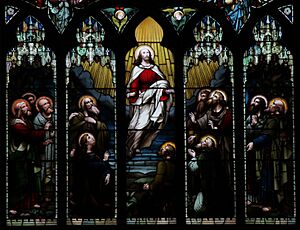
By the 1860s, people in Scottish Presbyterian churches were more open to stained glass. Adding new windows was a key part of William Chambers' plan to restore St Giles'. The Ballantine & Son company was hired to create windows showing the life of Christ. This series starts in 1874 and ends with the great east window of 1877, which shows the Crucifixion and Ascension.
Other windows by Ballantine & Son include the Prodigal Son window. They also made the window showing the assassination and funeral of Regent Moray. This is the only window in the church that shows Scottish history.
Different generations of the Ballantine company made windows with shields in the choir. Daniel Cottier designed a window showing Christian virtues. Edward Burne-Jones designed a window in the north nave aisle (1886). It shows Joshua and the Israelites.
20th Century Windows
Oscar Paterson made a window showing saints linked to St Giles'. Karl Parsons designed a window with Scottish saints. Douglas Strachan created the north transept window (1922). It shows Christ walking on water and calming the sea.
Later 20th-century windows include one by William Wilson showing Saint Andrew. The most important recent window is the great west window, a memorial to Robert Burns (1985). It replaced an older window.
Special Memorials
St Giles' has over a hundred memorials. Most are from the 1800s onwards.
In medieval times, the floor of St Giles' had memorial stones. These were mostly cleared after the Scottish Reformation. During the Burn restoration (1829–1833), most memorials were destroyed.
Adding memorials to famous Scots was a big part of William Chambers' plan. He wanted St Giles' to be like "Westminster Abbey of Scotland." A special board was set up in 1880 to manage new monuments.
Old Memorials

Old tomb areas remain in some aisles. Pieces of old memorial stones have been put back into the Preston Aisle.
A metal plaque for Regent Moray is on his monument. It shows Justice and Religion next to his shield. This plaque was saved from an earlier monument that was destroyed.
A tablet in the basement remembers John Stewart, 4th Earl of Atholl, who was buried in 1579. A plaque for the Napiers of Merchiston is on the north outside wall of the choir.
Victorian and Edwardian Memorials
Most memorials from between 1829 and 1883 are now in the north transept. These include white marble tablets for important people. The largest is a big plaque for George Lorimer, a hero of a fire.
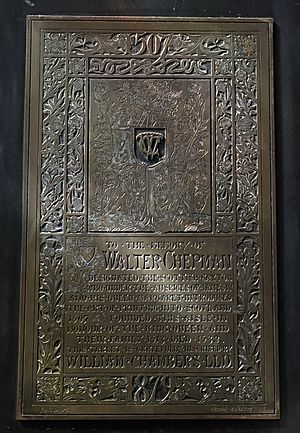
William Chambers, who paid for the restoration, commissioned a memorial plaque for Walter Chepman (1879). Chambers himself is remembered by a large plaque in the Chambers Aisle. William Hay, the architect, has a plaque with his portrait.
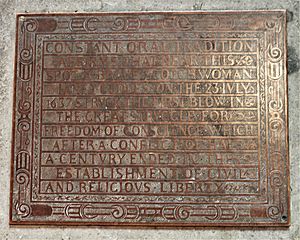
The first memorial after the Chambers restoration was for Dean James Hannay. He was the cleric whose reading of the prayer book caused the 1637 riot. In response, a plaque was put on the floor for Jenny Geddes, who supposedly threw a stool at him. Other historical figures like Gavin Douglas and John Knox are also remembered.
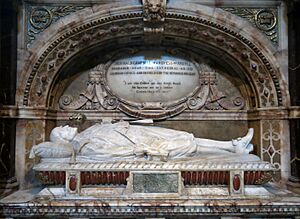
The biggest memorials of this time are for James Graham, 1st Marquess of Montrose and his rival, Archibald Campbell, 1st Marquess of Argyll. Both are large, detailed monuments with life-size statues.
A life-size bronze statue of John Knox stands in the north nave aisle. It used to be in a Gothic niche.
20th and 21st Century Memorials
In the north choir aisle, there's a bronze plaque for Sophia Jex-Blake (1912). Robert Lorimer designed it. Lorimer himself has a large stone plaque. Many plaques in the "Writers' Corner" have portraits of famous writers like Robert Louis Stevenson.
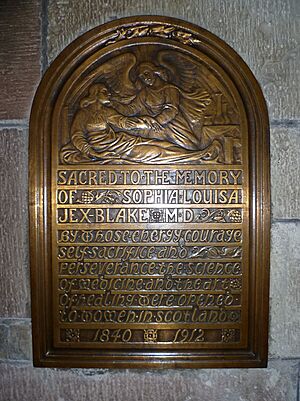
Modern sculptures include a bronze stool for Jenny Geddes (1992). The newest memorials are plaques for James Young Simpson (1997) and others.
Military Memorials
Victorian military memorials are mostly at the west end of the church. The oldest is for soldiers who died of disease in India (1850). Another is for the Indian Rebellion of 1857.
John Rhind made a large brass Celtic cross for the Royal Scots Greys (1886). Other memorials remember soldiers from the Second Boer War.
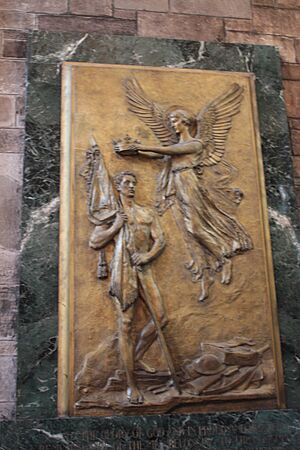
The Elsie Inglis memorial (1922) shows angels. Other memorials remember soldiers from the Gallipoli Campaign and the Royal Army Medical Corps.
Henry Snell Gamley made the church's First World War memorial (1926). It's a large bronze carving of an angel crowning a soldier. It lists the 99 church members killed.
The names of 38 church members killed in Second World War are in the Albany Aisle. This aisle was made a war memorial chapel in 1951.
Church Features
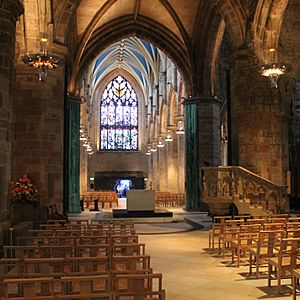
Before the Scottish Reformation, St Giles' had many stone altars. It also had a pulpit, chandeliers, and choir stalls. In 1558, the church's treasures were valued, including a special container for Saint Giles' arm bone. After the Reformation, the inside was stripped bare. A new pulpit became the main focus. Seating was added for children and city leaders.
When William Hay restored the church in 1872–83, the last internal walls were removed. The church was set up to face the communion table at the east end. Most of the church's furniture is from this restoration onwards. Since 1982, the church has been set up with seats facing a central communion table under the crossing.
Pulpits, Tables, and Font
The main pulpit is from 1883. It's made of stone and marble and has carvings of acts of mercy. Another wooden pulpit stands in the Moray Aisle. St Giles' had a wooden pulpit before the Reformation.
A brass eagle lectern (a stand for reading) is on the south side of the crossing. Its bronze steps were added in 1991.
The communion table in the crossing is a white marble block from 2011. It replaced a wooden table. The Albany Aisle has a communion table from 1951.
The communion table and screen in the Chambers Aisle were designed in 1927–29. The screen has a carving of angels adoring baby Christ.
The stone font is a kneeling angel holding a shell. It's a copy of a font in Copenhagen. It has been moved to different places in the church over the years.
Seating
Since 2003, new chairs have replaced older ones. Two rows of choir stalls are in the south transept.
There has been a royal pew in St Giles' for a long time. The current monarch's seat has a tall back and canopy with the royal arms of Scotland. It was made in 1953.
Metalwork, Lighting, and Plate
The gates and railings in several aisles were made by Francis Skidmore during the Chambers restoration. The gates and font bracket in the Chambers Aisle are by Thomas Hadden. The west door has a metal and blue glass screen.
The church is lit by stainless steel and aluminum chandeliers. They look like lilies. They were made between 2007 and 2008. Older gas chandeliers were replaced by electric ones in 1911. A red glass "Lamp of Remembrance" hangs in the Albany Aisle.
The church has communion cups from 1643 and flagons from 1618. It also has silver plates and a ewer (a type of pitcher).
Clocks and Bells
The current clock was installed in 1911. It replaced an older clock from 1721. A clock is first mentioned in 1491.
The hour bell was cast in 1846. It might have been made from the metal of a medieval bell. Two other bells chime the quarters. Between 1700 and 1890, a carillon (a set of bells) of 23 bells hung in the tower. One of these bells is now in a wooden frame near the Chambers Aisle. The bell of HMS Howe also hangs nearby. An old bell from 1464 stands in the south nave aisle.
Flags and Heraldry
Since 1883, regimental colours (flags) have been hung in the nave. In 1982, they were cataloged and preserved. The banners of the current Knights of the Thistle hang in the Preston Aisle. A large wooden panel with the arms of George II hangs on the tower wall.
The Fetternear Banner, the only surviving religious banner from before the Scottish Reformation, is held by the National Museum of Scotland.
National Covenant
St Giles' has one of the original copies of Scotland's National Covenant from 1638. This copy was signed by important Covenanters. It was given to St Giles' in 1926. It is now in a simple wooden frame in the Chepman Aisle.
The Thistle Chapel
The Thistle Chapel is at the south-east corner of St Giles'. It is the special chapel for the Order of the Thistle. You can enter it from outside the church or from the south choir aisle.
When the Order of the Thistle was founded in 1687, King James VII wanted Holyrood Abbey to be its chapel. But a mob destroyed the inside of the chapel the next year. In the 1800s and early 1900s, there were ideas to create a new chapel for the Order. In 1906, after a large donation, King Edward VII ordered a new chapel to be built at St Giles'.
Robert Lorimer was chosen as the architect. The King wanted Scottish craftspeople to build the chapel. Lorimer brought together a team of leading artists and craftspeople. Construction began in 1909 and was finished just over a year later. King George V knighted Lorimer for his work in 1911. New stall plates, crests, and banners are still added for new knights. The Knights of the Thistle meet in the Chapel at least once a year.
Experts say Lorimer did a great job creating a tall, Gothic work of art in a small space. Many have noted how the chapel shows the teamwork of individual artists. Some also say it expresses Scottish pride and loyalty to the monarchy.
Worship and Services
Services and Liturgy
St Giles' holds three services every Sunday:
- 9:30 a.m.: Morning Service – With Choir, Sermon, and Holy Communion
- 11:00 a.m.: Morning Service – With Choir and Sermon
- 6:00 p.m.: St Giles' At Six – A program of music
Every weekday, a service is held at 12 noon. The Sunday morning service is also streamed live online.
Before the Scottish Reformation, St Giles' used a special service style. After the Reformation, services followed the Book of Common Order. Singing of Psalms replaced choir music. Preaching became the main part of worship. Public penance (showing sorrow for sins) was also introduced. Communion services were held three times a year. People sat around tables, a practice that continued until the 1870s.
The attempt to replace the Book of Common Order in 1637 caused a riot. This led to the signing of the National Covenant. Later, new prayer books were used.
Cameron Lees, a minister from 1877 to 1911, helped bring back more formal worship in Scottish Presbyterian churches. He introduced Christmas, Easter, and Watchnight services. Daily services were also started again. Later ministers continued these changes. A weekly communion service was introduced. The current pattern of four Sunday services was adopted in 1983.
Notable Services
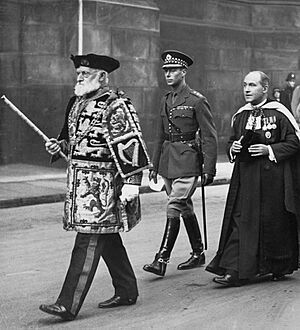
Since medieval times, St Giles' has hosted important city and national services. Important yearly services include Edinburgh's Remembrance Sunday service. There's also a service for the city council and for the legal profession. The Thistle Service for the Knights of the Thistle is also held here. A service is held during the General Assembly of the Church of Scotland. The Kirking of the Parliament has been held in St Giles' for every new session of the Scottish Parliament since 1999.
St Giles' has a close link with the Scottish and British royal families. The royal Knights of Thistle, including the Queen, attend the Thistle service every two years. There has been a royal pew in St Giles' since the 1500s. Important services for the royal family include a service for King James I (1437). King George IV attended a service in 1822. Queen Elizabeth II received the Honours of Scotland here in 1953.
Other important services include a memorial for those who died at the Battle of Flodden (1513). Thanksgivings were held for the Scottish Reformation (1560) and the Union (1707). A service marked the opening of the first Edinburgh International Festival (1947). Recent services have marked the return of the Stone of Scone (1996).
St Giles' has hosted the lying-in-state of Elsie Inglis (1917) and Douglas Haig (1928). Recent funerals include Robin Cook (2005).
Choir
The St Giles' Cathedral Choir has 30 adult singers. They sing at Sunday morning services. The Choir has toured internationally and appeared on TV and radio. They have also released recordings.
The current Choir was started in 1879. Before the Scottish Reformation, St Giles' had a song school with choristers. This school fell into disrepair but was restored just before the Reformation. After the Reformation, music was still taught there.
Pipe Organ

The pipe organ was finished in 1992. It's in the south transept. It was made by Rieger Orgelbau. The organ has 4,156 pipes.
This organ replaced an older one from 1878. That was the first organ in the church since the Scottish Reformation. The old organ was rebuilt several times. It was removed in 1990.
Since 1996, Michael Harris has been the organist and Master of Music.
Church Leaders
Clergy
The current minister of St Giles' is Calum MacLeod. He became minister in 2014. The assistant minister is Craig Meek. Many ministers of St Giles' have also served as Dean of the Thistle. In 1980, Helen Alexander became the first woman assistant minister in St Giles'. Besides the minister, St Giles' has a church council of about 50 elders.
The first recorded vicar of St Giles' was John in 1241. Some 1400s vicars were important churchmen and worked for the Scottish royal court. In 1467, St Giles' became a collegiate church. The role of vicar was replaced by a provost and sixteen canons. William Forbes was the first provost. He was followed by Gavin Douglas, who translated a famous poem in 1513.
In 1559, John Knox, a leader of the Scottish Reformation, became the first Protestant minister of St Giles'. He served until his death in 1572. Knox's followers were important in opposing King James VI's religious changes.
Parish and Historic Congregations
The current area St Giles' serves (its parish) covers part of Edinburgh's Old Town. From medieval times until 1598, St Giles' parish covered all of Edinburgh.
After the Reformation, St Giles' was divided inside into smaller churches. From 1561 to 1564, the west of the nave was divided. The upper floor was for worship, and the ground floor was an extension of the Tolbooth. Around 1581, the choir was separated to create the New or East Kirk. The rest of the church became the Great or Old Kirk.
In 1598, Edinburgh was divided into four church areas, each with two ministers. St Giles' held three of these areas. In 1620, one group moved to a new church.
In 1633, St Giles' became a cathedral, and some internal walls were removed. Later, in 1641, Edinburgh was divided into six parishes. St Giles' held three of these. In 1699, another group moved into the northern part of the Tolbooth section.
The different church groups gradually left St Giles' over the years. The last group left in 1881. Since 1883, the main church group has used the entire building.
St Giles' in Stories and Movies
The real story of a smuggler escaping from the Tolbooth Kirk in 1736 is used in the book The Heart of Midlothian by Walter Scott (1818).
St Giles' is mentioned twice in The Prime of Miss Jean Brodie by Muriel Spark (1961). It's a place the characters pass by and a symbol in the story.
In Disorderly Knights (1966) by Dorothy Dunnett, the main character swears an oath and has a duel in St Giles'.
In the movie Avengers: Infinity War (2018), St Giles' is one of the places where a fight happens. The scenes were filmed around the cathedral in 2017.
See also
 In Spanish: Catedral de Edimburgo para niños
In Spanish: Catedral de Edimburgo para niños


